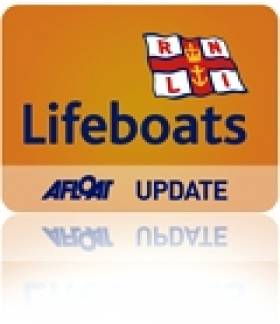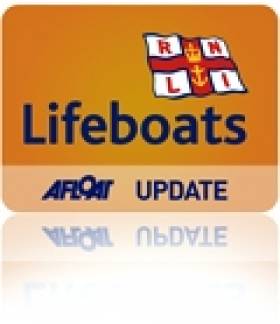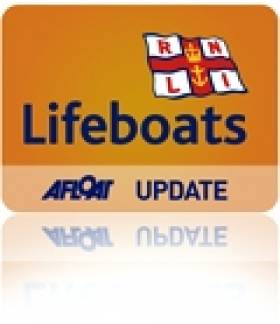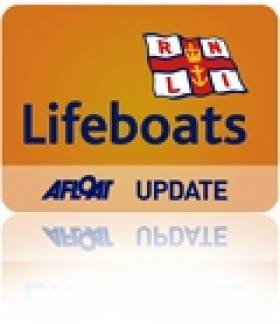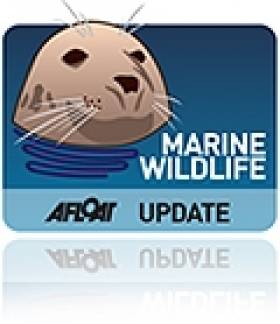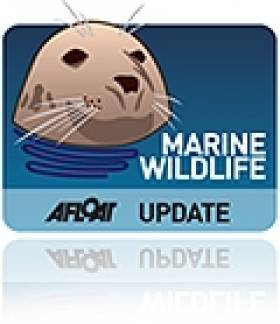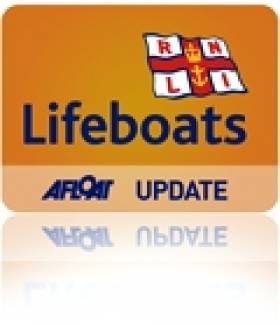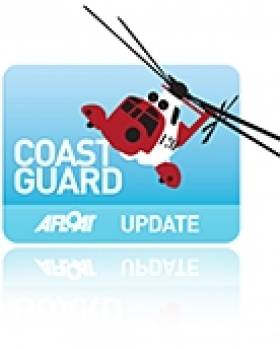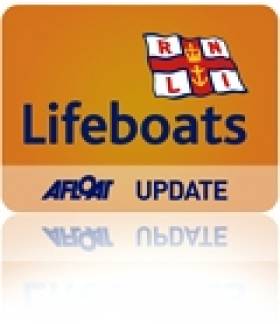Displaying items by tag: Portaferry
Dickie Brown 1933-2014
Dickie Brown of Portaferry, builder of the Ruffian range of yachts and one of Ireland's most accomplished sailors, has died at the age of 81 after a long and well-lived life. His three abiding passions were his family, his boats and their interaction with the sea, and devoting his working career towards increasing the prosperity and quality of life in his home town of Portaferry.
Portaferry is at the far southern end of the long Ards Peninsula in County Down, set on the east side of the tide-riven Narrows which flow from the Irish Sea into Strangford Lough. The ferry service across the Narrows to Strangford village to maintain the connection with central County Down has not always been the efficient link it is today, and for much of their boyhood the three Brown brothers - Tom, Billy and Dickie – lived in an isolated town which for many was economically deprived.
However, the brothers were able to break away from the limitations of small town life. Tommy followed a career in law which resulted in his becoming Sir Thomas Brown, while Billy – after service in World War II flying from aircraft carriers with the Royal Navy - became a university lecturer in physics, electronics and engineering. But Dickie – after various youthful adventures – was determined to be Portaferry-based, and his brothers were to back him in his boat-building project with Weatherly Yachts, for which Billy was the successful designer.
It was only after considerable experience in sailing and other areas of business that they felt sufficiently confident to set up the firm. In his younger days, Billy had become the owner of the Marie Michon, a notably hefty 28ft gaff cutter based on the Falmouth Working boat type. It was on this boat that Dickie had his first seagoing experience, so it was intriguing that when he decided to get a boat of his own inclinations in partnership with Billy in 1962, he went in completely the opposite direction, and settled on Black Soo, a 1957-built ultra-light Van de Stadt-designed 30ft offshore racing cutter of very minimal accommodation.

She was just a slip of a boat. Dickie Brown working on the topsides of Black Soo at Portaferry pier in 1964. Photo: W M Nixon
He bought the boat through her builders, Bob and Wally Clark of Cowes, thereby forming another of many lifelong friendships through which he learned much about the ways and means of running a boat-building operation and surviving in the marine industry. When Black Soo appeared for the first time in the decidedly conservative setting of Northern Ireland sailing 52 years ago, she looked sensationally different to anything else on the growing local offshore racing scene. But she successfully came through the gale-tossed first RUYC Ailsa Craig Race of 1962, and in 1963 she won it overall, going on through the mid 1960s to cut a swathe through fleets on both sides of the North Channel and in the Irish Sea, with a sensationally-fast performance in any heavy weather offwind sailing.
By 1967 Dickie had done his first Fastnet Race as a crewman, and after his second in 1969 he decided to build himself a 35-footer to his own ideas with the design created by brother Billy, who by this time had moved back to live in Portaferry and raise a family. Billy was to find that he did his best yacht design work after about three o'clock in the morning, "when the air isn't cluttered by other people thoughts".
Dickie meanwhile had married Joyce, a talented New Zealand artist, and they'd built themselves a house on the side of Bankmore Hill, right above the narrowest part of the Narrows and looking north into Strangford Lough. At the bottom of the field which now became the garden, a shed went up. It was originally planned as a pig house, as agricultural production was one of Dickie's many business interests. But soon the pigs were out, and the hull of a 35-footer started to appear instead, built upside down in three glued skins of diagonal planking and superbly constructed, for Dickie was a natural craftsman in wood.
Thus was Ruffian created, and it was a wonderful day in the early summer of 1971 when she was launched for the first time in a carnival family and community effort, the day going so smoothly, with successful afternoon sailing trials, that Joyce was moved to create a watercolour of it all, and that picture can still be seen in Portaferry today.
Ruffian made an impressive debut during 1971, but it was 1972 which saw her at her best on the offshore scene at home and abroad, winning practically everything she took part in. Yet she was already for sale, as the genesis of Weatherly Yachts was well under way, and in March 1973 the prototype of the GRP Ruffian 23, designed in Portaferry, built in Portaferry, and first sailed in Portaferry, made her successful debut.
The Ruffian 23 was the right boat at the right time. Local offshore racing was developing at many centres, and the able and attractive little performance sailer found ready buyers at home and abroad. At the height of its success, the Ruffian 23 was to be found in varying and often substantial numbers in places as widespread as Belfast Lough, Strangford Lough, Dublin Bay, the Isle of Man, Scotland, northwest England, Iceland and Hong Kong.

The prototype Ruffian 23 on her maiden sail, March 1973. Photo: W M Nixon
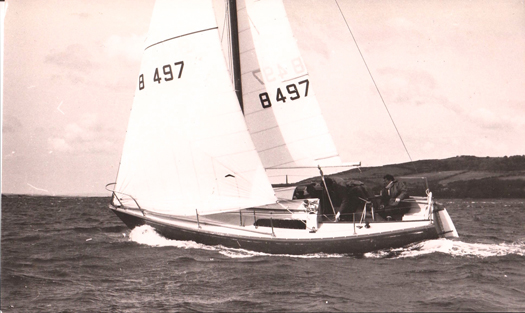
The right boat in the right place at the right time in 1973. The gallant little Ruffian 23 attracted adherents worldwide, and continues to race as a class in Dublin Bay and at Carrickfergus. Photo: W M Nixon
Today the class is still to be actively found in Dublin Bay and at Carrickfergus. But racing inshore and offshore wasn't the only area of success, Ruffian 23s were also cruised extensively with round Ireland ventures, and voyages to distant exposed islands such as St Kilda, satisfyingly completed. The Ruffian 23 sailors formed a maritime brotherhood (and sisterhood) which many maintain to this day, even when they have moved on to larger craft.
Weatherly Yachts also moved on to larger models, while maintaining a steady production of Ruffian 23s to provide good work in that former unemployment blackspot. New ventures included the 30ft Half Tonner Rock'n Goose (it's the local pronunciation for Rock Angus, the lighthouse-topped reef in the Narrows) which took part in the Half Ton Worlds at La Rochelle in France in 1974, and came through unscathed from a 180 degree roll in a huge Biscay storm, her survival in good order a credit to Dickie's boat-building skills. But for the next boat up in their range, Weatherly eventually settled on the 28ft Ruffian 8.5, which achieved success in a variety of ways, not least in the late Mike Balmforth's Sgeir Ban, which was fractionally-rigged to give a potent performance, and also proved herself as a very able cruiser on the Scottish and Irish coasts.
When the going was good for Weatherly Yachts of Portaferry, it was very good. But the increasing dominance of large often government-backed Continental companies in the mass-production boat-building industry meant that the longterm prospects for a small family firm in a remote location were increasingly negative. In fact, looking back, we can now realize that the Brown brothers with Weatherly Yachts hit the ground running with good ideas and a keen workforce just at the one juncture when a business with this scale and location could succeed, and they made the very best of the opportunity to provide a golden era for Portaferry.
With the firm quietly closing down after a gallant effort, Dickie was able to return to other business interests and his first love afloat – classic wooden yachts. His boat for the final long phase of his life was very different from the boisterous little plastic Ruffians, as it was the exquisite teak-built Arthur Robb-designed 42-footer Jaynor, which Dickie as a young man had watched being meticulously built by Bruce Cowley in Bangor Shipyard on the shores of Ballyholme Bay in the early 1960s.
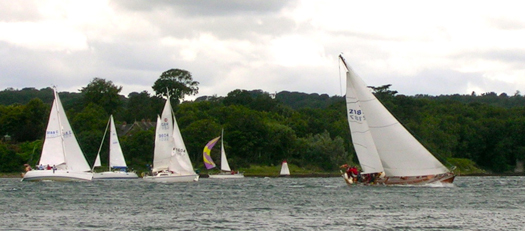
The classic yacht for a senior sailor. Jaynor with Dickie Brown at the helm storms into the lead at a breezy Portaferry Regatta. Photo: James Nixon
Dickie Brown and his family and friends with Jaynor became a familiar sight at classic events at home and abroad, but always his first love was to be sailing from Portaferry on the waters with which he'd been engaged all his life. Eventually, ill health meant Jaynor had to be sold, but even despite his infirmities, Dickie was still able – in his 80th year – to take part and finish in the Golden Jubilee Ailsa Craig Race in 2012, one of the very few who had done the same in the first race of 1962.
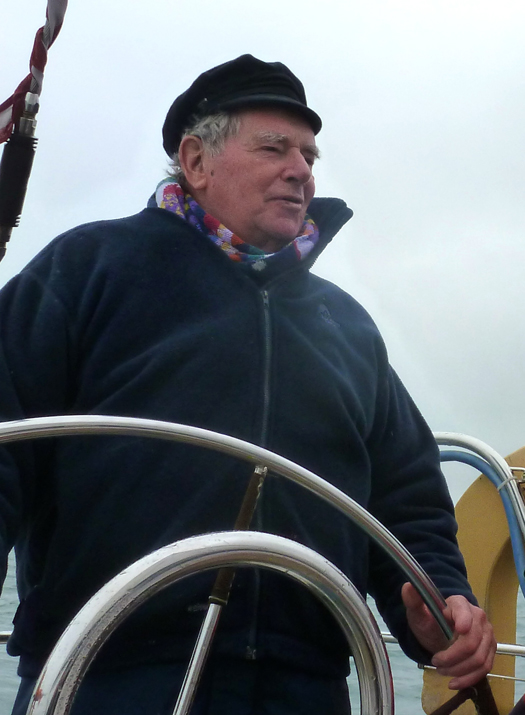
The lifelong enthusiast. Dickie Brown at the helm at the finish of the Golden Jubilee RUYC Ailsa Craig Race in 2012. He regularly sailed in the race from its inception in 1962, and was overall winner with Black Soo in 1963. Photo: W M Nixon
Now into his eighties, and with grandchildren to cherish, his interest in boats and his home waters never diminished, and he had many friends to help him get afloat. My own last sight of him out in a boat was just last year. We were coming in to Strangford Narrows with the new flood, and there was a useful little fishing launch bobbing about on the bar, having come down with the last of the ebb to take advantage of any good fish coming in on the new tide.
As we shaped on our course into the Narrows, the little boat completed her brief but successful task and started to head home to Portaferry, motoring alongside us for a while to say hello. It was Dickie and some friends, in good form and out for a spot of neatly-timed fishing before Sunday lunch.
It was a moment to treasure, a good way to remember a great man of the sea and the coast, a man who enriched the lives of all who knew him. Our thoughts are with Joyce, and Richie, Fraser (a former Olympic sailor for Ireland in 2004) and Karen and the grandchildren at this sad time.
WMN
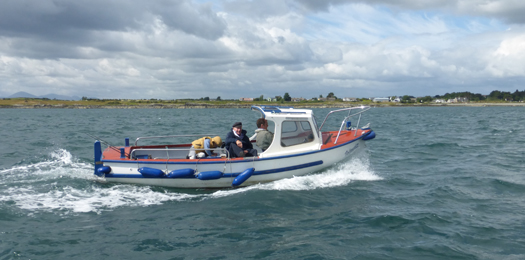
A last sight of Dickie Brown afloat on his home waters. It's August 2013, and with some friends he has come down through Strangford Narrows with the last of the ebb for some useful fishing on the bar, and is now returning to Portaferry with the new flood, nicely on time for Sunday lunch. Photo: W M Nixon
Portaferry Lifeboat Assists Family On Stranded Yacht
#RNLI - Portaferry RNLI received a request to launch their inshore lifeboat at 10.40am this morning (22 July) to the aid of a family on board a stranded yacht.
The lifeboat launched at 10.47am and arrived at the scene just south of Dogtail Point in Strangford Lough, Co Down seven minutes later.
The 13m yacht had run onto rocks where it remained stranded with the two adults and two children onboard until the help arrived.
Weather conditions at the time were very foggy with poor visibility, a Force 2 southerly breeze and calm seas.
When the volunteer crew from Portaferry RNLI arrived, they were assisted by the crew of a local boat, the Cuan Rib, in easing the stranded yacht on board clear of the rocks.
The volunteer lifeboat crew then inspected the yacht for damage at the scene before escorting the vessel and its passengers safely back to Portaferry Marina.
#RNLI - Portaferry RNLI launched its inshore lifeboat yesterday afternoon (14 July) to the aid of a man who had suffered a head injury in one of the races during Portaferry Sailing Club’s annual regatta.
The lifeboat launched at 2.36pm and met up with the injured man a few minutes later on board his 12m yacht just off Marfield Bay in Strangford Lough, Co Down.
Weather conditions at the time were cloudy with good visibility, with a Force 2 to 3 southerly wind and calm seas.
After assessing the injured man’s condition, the volunteer crew transferred him into the lifeboat before taking him to Strangford Harbour, where he was then passed into the care of the Northern Ireland Ambulance Service.
Around the same time, RNLI Bangor was launching to investigate reports that children could have been on board an abandoned homemade raft spotted adrift off Ballymacormick Point on the edge of Belfast Lough.
Calm seas and fine weather allowed the lifeboat to proceed at full speed to the search area between Ballymacormick Point and Orlock Point.
After an extensive two-hour search of the area in conjunction with a fishing vessel and a coastguard rescue team, nothing was found.
The search was later terminated when enquiries found that there was a high probability that the raft had drifted from shore during high water.
Michael McKenna, volunteer RNLI helmsman who was involved in the search, took the opportunity to remind all children playing along the coast of the SAFE code: S for spot the dangers, A for always go with a friend, F for find and follow the safety signs and flags and E for Emergency - put up your hand and shout or ring 999/112 and ask for the coastguard.
It was the third callout for Bangor RNLI in three days, after a busy Saturday 12 July that began with a morning request from Belfast Coastguard to assist in the search for an inflatable dinghy.
The dinghy had been spotted by a concerned member of the public at the mouth of Larne Lough. The Bangor volunteer crew joined the Larne RNLI lifeboat in the search for the dinghy and its occupants. The former were quickly on scene and found the dinghy deserted with its engine down and a rope around the propeller.
The name painted on the dinghy hull was passed to Belfast Coastguard who were able to contact the owners. Thankfully, the owners reported that the dinghy had broken free from their vessel and that no one was on board.
The second call of the day came at 11:55am when the Bangor lifeboat launched to rescue four people from a motor boat that had broken down off the oil jetty at Cloghan Point, on the northern shores of Belfast Lough.
On scene, the RNLI crew quickly evaluated the situation and manoeuvred the lifeboat close to the broken-down vessel.
With relatively calm weather conditions, a tow rope was rigged and successfully passed to the motor boat, which was then towed the four miles back to the safety of Bangor Marina.
"Engine failure close to shore could lead to a life-threatening situation," said Bangor RNLI volunteer helmsman Iain Dobie.
"We always urge everyone going to sea to make sure their electrical systems and engine are well maintained and in good working order. A good anchor and chain should always be carried as part of essential safety equipment.
"We are glad the family on board this vessel are now safely ashore," he added.
Four Calls In 24 Hours For Portaferry Lifeboat
#RNLI - The volunteer lifeboat crew at Portaferry RNLI responded to four separate calls in the space of 24 hours between Thursday 29 and Friday 30 May.
The first call was received at 6.07pm on Thursday to help four people on board a small powerboat with engine problems near Church Point in the Strangford Narrows area of Strangford Lough.
Weather at the time was cloudy with good visibility, a calm sea and Force 2 easterly winds. The volunteer crew launched at 6.13pm and were on scene with the two adults and two children onboard the powerboat within three minutes.
By this stage the people onboard the powerboat had managed to re-start their engine and made their way to the pontoons at Strangford. The RNLI crew made sure that everyone onboard the vessel was safely on shore before the volunteer lifeboat crew returned to station at Portaferry.
Not long after, a second call was received at 8.40pm from HM Coastguard requesting the RNLI to investigate a 10-metre yacht that appeared to have slipped its moorings and beached near the old Katherine Quay in Strangford, Co Down.
Once again, the weather was cloudy with good visibility, a calm sea and Force 1 easterly wind. The volunteer crew launched at 8.45pm and were on scene two minutes later, where they found two men on board and helped fix a line to secure the yacht so that it would not drift when the tide rose.
Once the yacht was secured, the lifeboat crew confirmed that the two men were happy to remain onboard while the lifeboat crew returned to station in Portaferry.
The third and final call of the evening was received 9.57pm from two men onboard another 10-metre yacht with engine problems some 10 miles south-east of the Strangford Bar at the mouth of Strangford Lough.
The two men had set out earlier that evening from Portaferry to travel to Peel Harbour in the Isle of Man. The volunteer crew launched at 10.02pm and reached the stricken yacht at 10.35pm.
Once the vessel was located, they put a lifeboat crew member on board and started to tow the vessel and its crew towards Peel Harbour in the Isle of Man, letting the larger all-weather lifeboat from Peel RNLI take over as they approached. The Portaferry crew departed the scene at 11.20pm.
The fourth call was received at 4.50pm on Friday, requesting the volunteer crew to go to the aid of six people, five in canoes and one in a small motorboat, who had got into difficulty just off Church Point.
The RNLI volunteers launched the lifeboat at 4.50pm and arrived at the scene five minutes later. Weather conditions were similar to Thursday, cloudy with good visibility, a calm sea and a Force 1 northerly wind.
On scene, the lifeboat crew discovered that the small motorboat had gone to help five adults in two canoes who were entering the Narrows area of Strangford Lough.
Having secured the two canoes, the motorboat itself started to experience engine problems, resulting in all three craft starting to drift towards the SeaGen tidal power turbine in the Narrows.
The volunteer lifeboat crew intercepted the six people at the Scotsman Rocks South, just south of Strangford, taking all on board the lifeboat, securing the small motorboat and two canoes and bringing all safely into Strangford Marina where they were put ashore.
#RNLI - Portaferry RNLI's volunteer lifeboat crew were involved in the rescue of 23 canoeists who got into difficulty just off Castle Island in Strangford Lough yesterday afternoon (Saturday 17 May).
The call for help was received at 2.40pm and the volunteer lifeboat crew launched at 2.45pm.
They arrived at the scene just off Castle Island in Strangford Lough in Co Down 10 minutes later, finding six of the party of canoeists in the water.
Weather conditions at the time were cloudy with good visibility, with a slight sea swell and a Force 4 southerly wind.
The RNLI crew recovered two of the people from the water, while a small motor boat which had also come to the canoeists' aid took the other four on board.
The RNLI lifeboat crew then took their two casualties along with two canoes back to nearby Strangford Lough Yacht Club, where the casualties were put ashore into the care of HM Coastguard.
- lifeboat crew then returned to the scene near Castle Island and from there escorted the remaining 17 members of the canoe party back to the safety of the yacht club.
Commenting on the rescue, Portaferry RNLI lifeboat operations manager Brian Bailie said: "Thankfully everyone was brought safely to shore and it is testament to the training and dedication of the volunteer RNLI crew that a potentially tragic situation was averted.
"Strangford Lough is an extremely popular location for groups of canoeists and it is vital that they take all necessary precautions when taking to the water."
#MarineWildlife - BBC News reports that Northern Ireland's Exploris aquarium will remain open for another two months as Ards Borough Council prepares to submit its business plan to save the facility in April.
As previously reported on Afloat.ie, the popular but loss-making tourist attraction was earmarked for closure last year - threatening the future of its more than 3,000 marine animals - but saved at the 11th hour, provided the council receives a one-off capital grant of more than €1 million from Stormont.
It's hoped that this funding would be confirmed and the aquarium will get the green light to remain operational when the NI Executive makes its decision on the plan.
That would mean Exploris could stay open for the peak spring/summer period, and close in October for a necessary six-month refurbishment over winter and next spring.
BBC News has more on the story HERE.
Portaferry Aquarium 'Saved' Pending £900k Govt Grant
#MarineWildlife - Northern Ireland's Exploris aquarium will be saved - provided the local council receives a one-off capital grant from Stormont.
BBC News reports that a new business plan to preserve the Portaferry aquarium, which is one of the North's biggest tourist attractions, has been agreed.
But the plan's success is subject to funding of £900,000 (€1.09 million) from the NI Executive as part of a financial rescue package for the facility.
Ards Borough Council, which has run the Co Antrim aquarium since its opening in 1987, says it can no longer afford its annual operating costs of some £500,000 (€600,000).
And its closure could see more than 3,000 marine animals presently housed in the facility destroyed.
Should the new funding be confirmed, Ards Borough Council would keep Exploris open for this year's peak spring/summer period before closing for a six-month refurbishment in the autumn.
The business plan for Exploris would also preserve the aquarium's seal sanctuary, although its own future was confirmed by Environment Minister Mark Durkan in November.
BBC News has more on the story HERE.
Fisherman Rescued By RNLI Crew Meets His Rescuers - And Owes His Life To Lifejacket Initiative
#RNLI - A fisherman whose boat sank in minutes has thanked several organisations who implemented and trained him on using a lifejacket for saving his life.
Samuel Cully, a fisherman from Portavogie, was in the water for 45 minutes after his vessel sank on Wednesday 18 September, off the coast of Co Down. Weather conditions at the time were rough seas with Force 5 to 6 winds blowing.
RNLI lifeboats from Portaferry and Donaghadee were launched within minutes of a May Day being received by the Belfast Coastguard, along with the Irish Coast Guard helicopter Rescue 116.
Recently Cully was reunited with the volunteer crew at Portaferry who rescued him.
Just weeks earlier, Cully had been provided with a personal flotation device in a grant-aided scheme run by the Fishermen’s Mission with funding and support from Seafish, the Department for Agriculture and Rural Development through the European Fisheries Fund, the Northern Ireland Fish Producers Organisation, RNLI, the Maritime Coastguard Agency and supermarket Asda.
The project aims to ensure that fishermen will receive a grant-aided PFD and the training required to ensure its proper use.
Frankie Horn, RNLI fishing safety manager for the UK and Ireland, said: "It’s great that Samuel is safe, and back with his family. We want fishermen to see the benefits of wearing a personal flotation device or lifejacket and for them to wear it voluntarily.
"This will be an ongoing process for us, talking to fishermen and working with the manufacturers to ensure that the PFDs provided are the best possible design for the fishing industry."
With the funding and logistics generously covered by other agencies, the RNLI was involved in leading the safety training session – an act that Cully is immensely grateful for.
"I was only able to swim five or ten metres or so, and even then the wind and swell were washing me away from the shore," he recalled. "The boat went down so quickly, and I was so relieved to find the lifejacket doing exactly what I was told it would do. I cannot thank all those organisations involved enough."
In more recent news, Donaghadee and Portaferry RNLI launched yesterday (Tuesday 8 October) to go to the aid of a man fishing off rocks who became stranded by the tide.
Belfast Coastguard had received a call from a member of the general public just after 10.20am alerting them of the emergency.
On arriving on the scene, Donaghadee's all-weather lifeboat crew found their colleagues from Portaferry RNLI's inshore lifeboat were taking the man off the rocks and returning him safely into Portavogie harbour.
Fisherman Rescued By Portaferry Lifeboat After Boat Capsizes off South Rock
#capsize – A man has been taken to hospital after his fishing boat capsized near South Rock, Northern Ireland.
Belfast Coastguard received a Mayday call at around 12:30pm today from the man on board the boat, who reported it was rapidly taking on water and sinking.
Belfast Coastguard repeatedly tried to get in touch with the vessel, but had no response.
They then sent the Irish Coast Guard Helicopter, RNLI Donaghadee Lifdboat, Portaferry RNLI Inshore Lifeboat, along with Coastguard Rescue Teams from Portaferry and Bangor, to his last reported position.
The man was spotted in the water and recovered by Portaferry Inshore Lifeboat. He was then winched onto the Coast Guard Helicopter and taken to the Royal Hospital, Belfast.
Ian Graham, Watch Manager at Belfast Coastguard, said: "We had to act quickly, with limited information, when we couldn't make further contact with the boat.
"Knowing the boat was taking on a lot of water, we sent several rescue units to make sure we could find the man as quickly as possible. Portaferry RNLI Inshore Lifeboat managed to pull the man out of the water, and he was then picked up by the Irish Coast Guard Helicopter who took him straight to hospital."
The Maritime and Coastguard Agency advises fishermen to make sure they're well prepared when heading out to sea, with as much life saving equipment on board as possible. This includes the necessary communications equipment, a liferaft, distress flares and personal flotation devices, which should be worn at all times whilst on deck.
The man was believed to be wearing a personal floatation device that was provided to him two weeks ago through a joint initiative by National Charity, the Fisherman's Mission, Seafish, the Department for Agriculture and Rural Development, through the European Fisheries Fund, and Asda.
Busy Weekend For Portaferry Lifeboat With Two Call-Outs
#RNLI - Portaferry RNLI had a busy start to the weekend with two call-outs last Friday (30 August).
The first call was received just before 3pm from a 5m Shetland open-top fishing vessel with two men and one child on board, who had lost power and run onto rocks near the entrance to Ardglass Harbour in Co Down.
The volunteer crew were on the water by 3.05pm and arrived on the scene 15 minutes later. Weather at the time was cloudy with good visibility and Force 4 northwest winds.
When the lifeboat crew arrived at the scene, the two men and the child had managed to climb onto the rocks to safety where they were met by a member of the coastguard.
The fishing vessel had lost power and by the time the crew could attempt to start the auxiliary engine the boat was washed onto the rocks. The lifeboat crew could do nothing to salvage the quickly sinking boat and remained at the scene until the two men and the child had been taken to safety.
The second call of the day was received at 9pm from a man and a teenager aboard a 27ft yacht that had lost engine power and was adrift close to the Fairway Buoy at the entrance to Strangford Lough in Co Down.
The volunteer crew launched at 9.07pm and were with the stricken yacht at 9.55pm after conducting a short search. The weather was fair with Force 4 to 5 northwest winds.
The lifeboat crew attached a line to the yacht and then proceeded to tow it nearly five miles to the safety of Portaferry Marina where they arrived at 11.20pm. The yacht was then securely moored in the marina and the two people on board safely put ashore.
Portaferry RNLI lifeboat operations manager Brian Bailie said: "It was certainly a busy start to the weekend for our volunteer crews and thankfully everyone was returned home safely.
"The skipper of the yacht which lost power at the mouth of Strangford Lough exercised good judgement calling for assistance when he did rather than attempting to sail back in what can be extremely tricky waters."



























